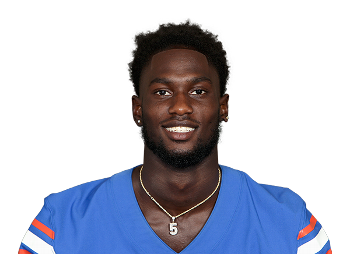
The Kansas City Chiefs attempted to get a top-tier cornerback by moving up the NFL draft order just two years ago. General manager Brett Veach has acknowledged that, while he thought someone the Chiefs wanted would be available, he wasn’t quite sure who would be there when the trade discussions began with the New England Patriots to move up from No. 29 to No. 21.
It turned out that after making the call through a few choices earlier to seal the deal, their best option, cornerback Trent McDuffie, was still available.
McDuffie was an All-Pro in his first full season as a starter, so Veach made a great decision thus far. But what about the other rumored top pick on the Chiefs selection board?
Kaiir Elam seems like a reasonable option as the other player in the Chiefs’ draft range in 2022. The Chiefs really jumped over the Bills, who were desperate for a cornerback, to acquire their man, and Buffalo wound up acquiring Elam in the process. With the pre-draft metrics scouts prefer to see in first-round prospects, both corners were seen as pro-ready.
Since then, though, in addition to the Patrick Mahomes trade and the playoff exits, the McDuffie transaction has caused Bills supporters even more pain about the Chiefs.

This is due to the fact that Elam has been inconsistent or injured since entering the league, and the Bills still don’t know what they have on hand halfway through his rookie contract.
Elam had no trouble getting on the field in his first season, but the opposition wasn’t exactly upset about that outcome. Elam’s statistics at Pro Football Focus paint a picture of an overmatched corner who appeared even worse versus the run, allowing over 75% of throws thrown his way to be completed. He also missed 13% of tackles.
Elam attempted to play with a ruptured ankle ligament this season in order to compete against Dane Jackson and Christian Benford, who were the Bills’ starting boundary cornerbacks opposite Tre’Davious White. Elam lost the match hands-down, but a window of opportunity opened up when Benford injured his shoulder and White suffered an ACL tear.
Unfortunately, Elam looked just as confused as he did the season before in the limited time he played in the middle of the game, giving up 10 of the 13 completions that were thrown at him. He was then put on injured reserve, where he stayed for the remainder of the regular season.
He did, however, return in the playoffs’ first game and help the Wild Card team defeat the Pittsburgh Steelers with an interception of Mason Rudolph.
Though it is true that none of this sounds very exciting as a possible acquisition, outside watchers of the organization have long questioned the Bills’ employment of Elam. Elam was selected by the Bills as a press-man cornerback even though they knew he would need to pick up their zone-dominant techniques. However, this was probably overdone because other corners can make these adjustments with easily. In all likelihood, Elam was simply a more undeveloped prospect overall than the Bills perceived.
A shaky start and an injury-plagued second season combine to create a huge question mark for the secondary going into his third campaign. This presents Kansas City with an opportunity and Buffalo with a dilemma.
Due to an ankle issue that troubled him in the second season, Elam is tough to judge and may end up in the same kind of bargain bin that Brett Veach used to like. Recall that in previous offseasons, he made passes on players like Mike Hughes, Reggie Ragland, Cam Erving, Kadarius Toney, and DeAndre Baker; therefore, adding Elam would be entirely consistent with his thinking.
All of this, of course, only makes sense in a scenario in which the Chiefs have given up on ever getting L’Jarius Sneed back for whatever reason. They could decide that he is too costly to retain in the long run and consider alternative candidates for any contract renewals.
The suggestion is moot since Sneed’s secondary is too heavy for Elam to consider making such a deal. Elam, in the absence of Sneed, is precisely the kind of impact player who would make sense in a secondary with other bets on potential, such as Jaylen Watson’s development, Joshua Williams’ progress, Chamarri Conner’s preparedness, and Nazeeh Johnson’s health.
Should the Chiefs lose a cornerstone such as Sneed in the secondary, a trade for a prospect like Elam addresses any depth issues and offers a risk worth taking on his development in year three. Elam, if healthy, has the potential to be a dynamic outside corner who would flourish under a new head coach (Dave Merritt, after all). Furthermore, the Chiefs really ought to aim for numerous darts to hit the goal of covering that hole when they’re faced with a void like going “Sneed-less”.
Considering that both parties would be taking calculated risks, a fourth-round selection seems like a sensible option.
For a club like the Chiefs, who selected Sneed and Conner in previous years, that’s a good round of value, especially because it lets them keep any pick in the top 100. In reaction, the Bills lose a lot to their first-round pick but get a genuine asset in exchange for a draft pick that may prove to be a total flop. Better than nothing, isn’t it?
It’s feasible to work in something that has a somewhat greater financial impact on both parties—for example, a fifth-round pick that has the potential to move up to a third-round selection with incentives related to playing time. However, the constraints exist so that both sides can experience the gain and risk.
Leave a Reply